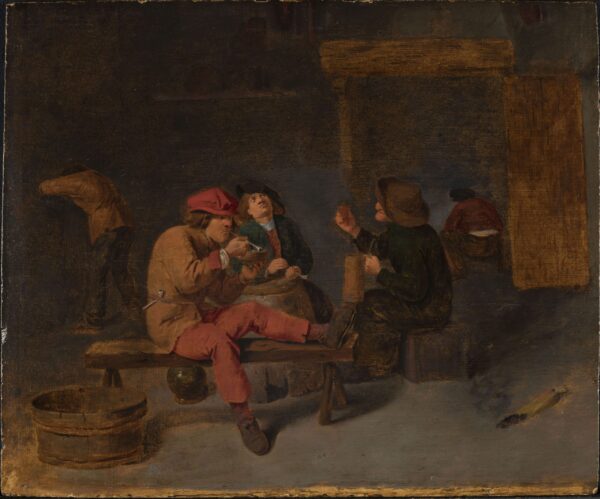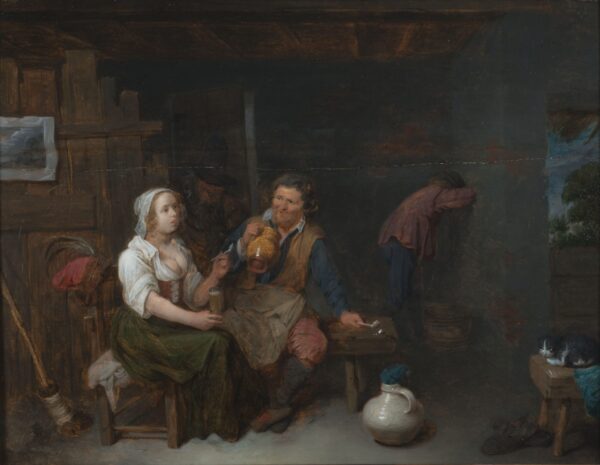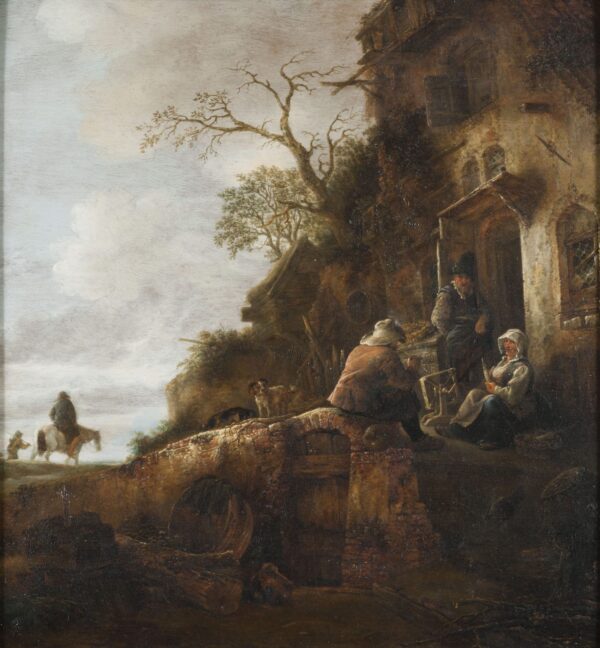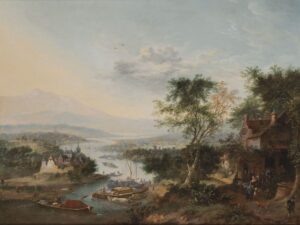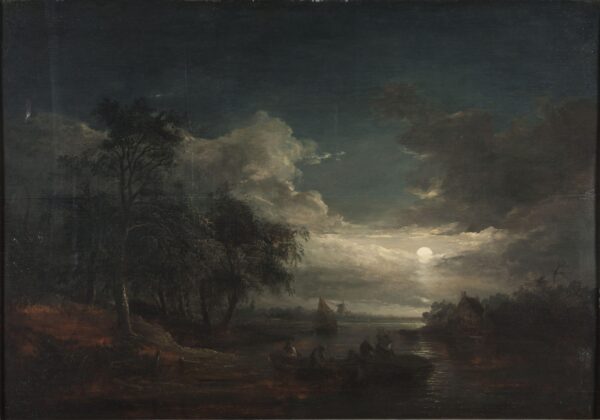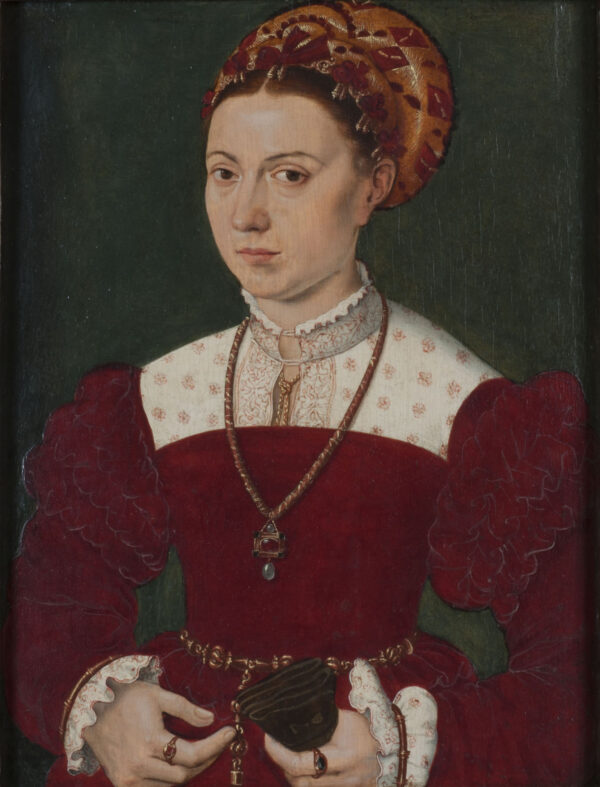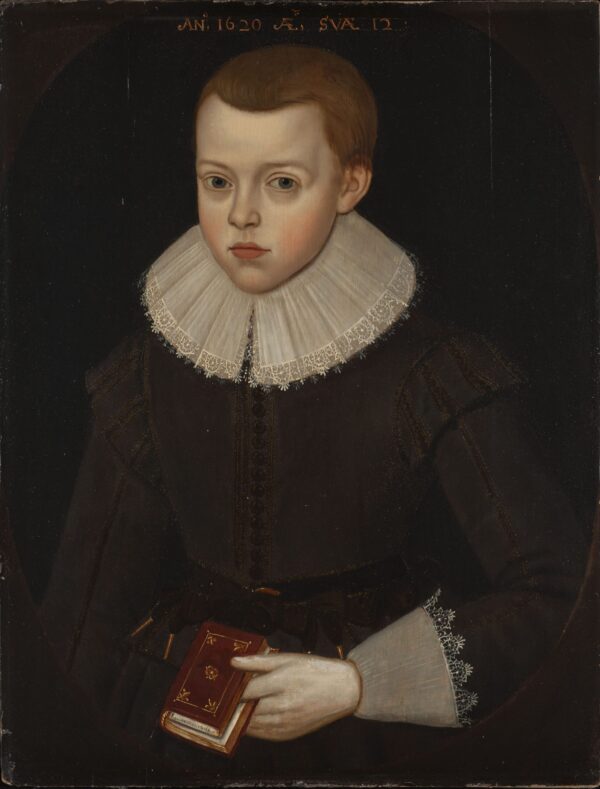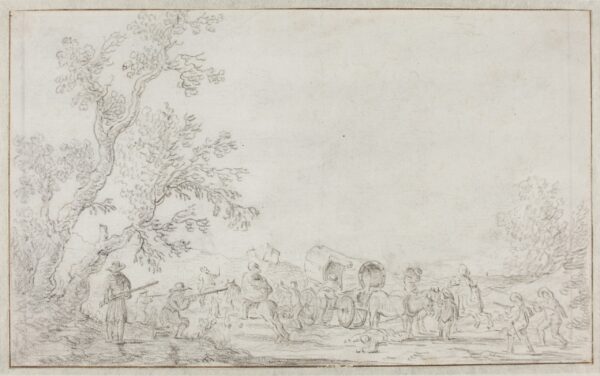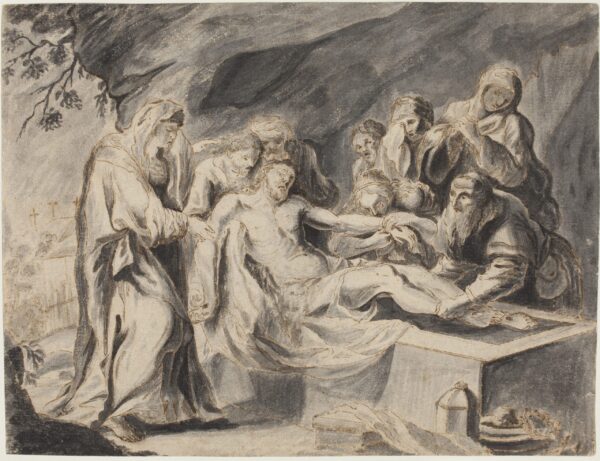Take a closer look at the artworks included in the exhibition Works in Progress: Original Materials from the Netherlands, which opened at the Picker Art Gallery on January 30, 2020 and will be installed through June 28, 2020. The gallery is currently closed to the public in response to the COVID-19 pandemic.
Pieter Brueghel II (Flemish, 1564–1638)
Winter Landscape with Ice-Skaters, after 1616
Oil on panel, 43.2 x 57.8 cm
Gift of Max Oberlander, 2011.10
Many figures are seen enjoying all that winter has to offer in this scene, based on a print by Hans Bol (1534–1593) first published in Antwerp in 1570. Pieter Brueghel II was the eldest son of Pieter Brueghel the Elder (ca. 1525–1569), in whose style he continued to work throughout his life. This painting is one of at least fifteen known identical versions of this composition, which testifies to the great popularity of the subject when it was made.
Workshop of Adriaen Brouwer (ca. 1605–1638)
Men Smoking in an Interior, ca. 1622–1638 (active)
Oil on panel, 36.8 x 44.5 cm
Gift of Max Oberlander, 2015.5.4
In this tavern scene three figures are seen drinking and smoking, while a man to the left suffers the consequences of overindulgence. A fifth figure sits by a fireplace in the back. Originally, smoke from this fire would have enveloped the figures in the foreground, defining the work’s subtle atmospheric qualities. This effect, along with a wisp of smoke escaping the lips of the central figure looking upward, were unfortunately lost during previous cleanings.
David Ryckaert III (Flemish, 1612–1661)
Interior of an Inn with Four Figures, ca. 1640
Oil on panel, 53.7 x 69.2 cm
Gift of Max Oberlander, 2015.5.3
Similar to the painting by Adriaen Brouwer’s workshop, the subject of this work revolves around the risks of indulging the senses. Here, the two central figures are an amorous couple seated in the foreground, whose feet touch to allude to the mix of intoxication and desire that is taking hold. A tally of imbibed drinks is kept in chalk on the stool to the right, where a cat looks at the viewer knowingly.
Isaac van Ostade (Dutch, 1621–1649)
Figures outside a Country House, ca. 1639-1649 (active)
Oil on panel, 50.8 x 47 cm
Gift of Max Oberlander, 2015.5.2
In contrast to the two tavern interiors nearby, the figures in this scene are seated outside in bright daylight. While the men seem idle, the woman is winding a skein of yarn, evoking the fruits of labor rather than leisure. A gifted colorist, Van Ostade has provided the texture of the decrepit wall in the foreground with almost jewel-like qualities, while the travelers trailing off to the left lend depth to the expansive sky behind.
Robert Griffier (Dutch, ca. 1675–1760)
River Landscape, ca. 1725
Oil on panel, 45.7 x 59.4 cm
Gift of Dr. Howard E. Wilson ’51, 1957.10
This landscape provides an almost panoramic overview of a bustling river valley. Boats depart to ship goods to cities and towns downstream, connecting this idyllic country scene to the urban centers where paintings such as these were bought and sold. As in the painting by Isaac van Ostade, figures are grouped outside a building to the right. Here the artist has likely represented a rest stop, where travelers enjoy refreshments and entertainment from an itinerant musician.
Unknown Artist
Previously attributed to Aert van der Neer (Dutch, ca. 1603–1677)
River Landscape by Moonlight, possibly nineteenth century
Oil on panel, 57.2 x 80.6 cm
Gift of Herbert Mayer ’29, 1966.1.792
When the Dutch art market expanded during the seventeenth century, artists developed highly specialized subject matter to meet increased consumer demand. In the 1640s, Amsterdam-based Van der Neer popularized moonlit landscapes that featured an innovative use of light and reflections. These romantic qualities made his work very popular during the nineteenth century, when copies and forgeries after the artist proliferated. Recent pigment analysis has determined that this work dates from a period after Van der Neer’s lifetime.
Unknown Artist
Portrait of a Woman, ca. 1530–1540
Oil on panel, 32.4 x 24.8 cm
Gift of Max Oberlander, 2015.5.1
This striking portrait of a young woman was likely painted during the 1530s. In the Renaissance period, costumes were far more than a fashion statement: contemporary audiences could deduce social markers from it, such as social class and marital status, or a person’s region of origin. Research into the possible identity of this mysterious lady in red—whose dress has been interpreted as French, Swiss, or even Tyrolean (a region in the Alps in the north of Italy)—continues.
Unknown Artist
Previously attributed to Cornelius Janssen van Ceulen (English, Flemish and German descent, 1593–1661)
Portrait of a boy, age 12 (possibly John Milton), 1620
Oil on panel, 54.5 x 42.5 cm
Gift of Capt. C. Michael Paul, 1959.70
According to the inscription on top, the boy in this work was twelve years old when he posed for his portrait in 1620. That makes him of the same age as famed poet John Milton (1608–1674), with whom the boy has been traditionally identified. Whether or not the sitter is indeed Milton, the decision to depict him holding a copy of Homer’s Iliad indicates that he (or his parents) wished to convey his early interest in letters.
Attributed to Pieter de Neyn (Dutch, 1597–1639)
Landscape with Ambush of Travelers, ca. 1617–1639 (active).
Black chalk on paper, 28.6 x 17.8 cm
Purchase of the Robert J. Gerberg ’59, P’85 Fund, 1996.9
De Neyn calls attention to the perils of the road in this swift and decisively executed drawing. The scene captures the dramatic moment in which robbers take ownership of the contents of a horse-drawn wagon that has been held up at gunpoint, leaving one traveler face-down in the center foreground. Specific details, such as the depiction of the meandering trees and the convincingly foreshortened horses support the attribution to this Leiden-based landscape painter.
Unknown Artist (Flemish)
Lamentation over the Dead Christ, seventeenth century
Pen and brown ink, grey wash on paper, 15.2 x 20 cm
Gift of William P. Carl ’74, 1986.44
This scene combines two emotionally charged moments from the Passion: the Lamentation and Entombment. Several figures, including the Virgin Mary, Mary Magdalene, Nicodemus, and Joseph of Arimathea are seen mourning Christ’s dead body as it is lowered into his tomb, while a view of Golgotha is provided to the left. The drawing is thought to be Flemish based on stylistic characteristics, yet its precise provenance and authorship remain unknown.
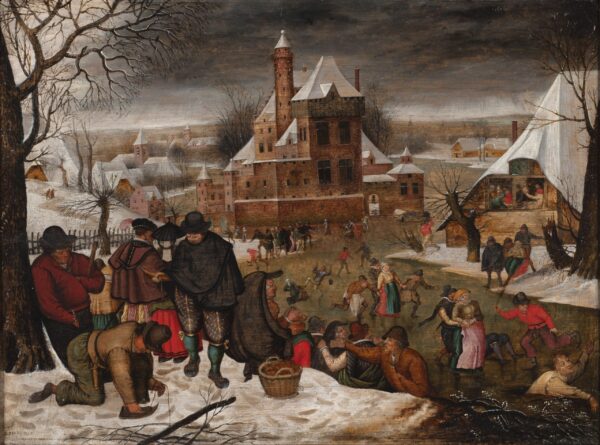
Pieter Brueghel II (Flemish, 1564–1638)
Winter Landscape with Ice-Skaters, after 1616
Oil on panel, 43.2 x 57.8 cm
Gift of Max Oberlander, 2011.10
Many figures are seen enjoying all that winter has to offer in this scene, based on a print by Hans Bol (1534–1593) first published in Antwerp in 1570. Pieter Brueghel II was the eldest son of Pieter Brueghel the Elder (ca. 1525–1569), in whose style he continued to work throughout his life. This painting is one of at least fifteen known identical versions of this composition, which testifies to the great popularity of the subject when it was made.
Workshop of Adriaen Brouwer (ca. 1605–1638)
Men Smoking in an Interior, ca. 1622–1638 (active)
Oil on panel, 36.8 x 44.5 cm
Gift of Max Oberlander, 2015.5.4
In this tavern scene three figures are seen drinking and smoking, while a man to the left suffers the consequences of overindulgence. A fifth figure sits by a fireplace in the back. Originally, smoke from this fire would have enveloped the figures in the foreground, defining the work’s subtle atmospheric qualities. This effect, along with a wisp of smoke escaping the lips of the central figure looking upward, were unfortunately lost during previous cleanings.
David Ryckaert III (Flemish, 1612–1661)
Interior of an Inn with Four Figures, ca. 1640
Oil on panel, 53.7 x 69.2 cm
Gift of Max Oberlander, 2015.5.3
Similar to the painting by Adriaen Brouwer’s workshop, the subject of this work revolves around the risks of indulging the senses. Here, the two central figures are an amorous couple seated in the foreground, whose feet touch to allude to the mix of intoxication and desire that is taking hold. A tally of imbibed drinks is kept in chalk on the stool to the right, where a cat looks at the viewer knowingly.
Isaac van Ostade (Dutch, 1621–1649)
Figures outside a Country House, ca. 1639-1649 (active)
Oil on panel, 50.8 x 47 cm
Gift of Max Oberlander, 2015.5.2
In contrast to the two tavern interiors nearby, the figures in this scene are seated outside in bright daylight. While the men seem idle, the woman is winding a skein of yarn, evoking the fruits of labor rather than leisure. A gifted colorist, Van Ostade has provided the texture of the decrepit wall in the foreground with almost jewel-like qualities, while the travelers trailing off to the left lend depth to the expansive sky behind.
Robert Griffier (Dutch, ca. 1675–1760)
River Landscape, ca. 1725
Oil on panel, 45.7 x 59.4 cm
Gift of Dr. Howard E. Wilson ’51, 1957.10
This landscape provides an almost panoramic overview of a bustling river valley. Boats depart to ship goods to cities and towns downstream, connecting this idyllic country scene to the urban centers where paintings such as these were bought and sold. As in the painting by Isaac van Ostade, figures are grouped outside a building to the right. Here the artist has likely represented a rest stop, where travelers enjoy refreshments and entertainment from an itinerant musician.
Unknown Artist
Previously attributed to Aert van der Neer (Dutch, ca. 1603–1677)
River Landscape by Moonlight, possibly nineteenth century
Oil on panel, 57.2 x 80.6 cm
Gift of Herbert Mayer ’29, 1966.1.792
When the Dutch art market expanded during the seventeenth century, artists developed highly specialized subject matter to meet increased consumer demand. In the 1640s, Amsterdam-based Van der Neer popularized moonlit landscapes that featured an innovative use of light and reflections. These romantic qualities made his work very popular during the nineteenth century, when copies and forgeries after the artist proliferated. Recent pigment analysis has determined that this work dates from a period after Van der Neer’s lifetime.
Unknown Artist
Portrait of a Woman, ca. 1530–1540
Oil on panel, 32.4 x 24.8 cm
Gift of Max Oberlander, 2015.5.1
This striking portrait of a young woman was likely painted during the 1530s. In the Renaissance period, costumes were far more than a fashion statement: contemporary audiences could deduce social markers from it, such as social class and marital status, or a person’s region of origin. Research into the possible identity of this mysterious lady in red—whose dress has been interpreted as French, Swiss, or even Tyrolean (a region in the Alps in the north of Italy)—continues.
Unknown Artist
Previously attributed to Cornelius Janssen van Ceulen (English, Flemish and German descent, 1593–1661)
Portrait of a boy, age 12 (possibly John Milton), 1620
Oil on panel, 54.5 x 42.5 cm
Gift of Capt. C. Michael Paul, 1959.70
According to the inscription on top, the boy in this work was twelve years old when he posed for his portrait in 1620. That makes him of the same age as famed poet John Milton (1608–1674), with whom the boy has been traditionally identified. Whether or not the sitter is indeed Milton, the decision to depict him holding a copy of Homer’s Iliad indicates that he (or his parents) wished to convey his early interest in letters.
Attributed to Pieter de Neyn (Dutch, 1597–1639)
Landscape with Ambush of Travelers, ca. 1617–1639 (active).
Black chalk on paper, 286 x 178 mm
Purchase of the Robert J. Gerberg ’59, P’85 Fund, 1996.9
De Neyn calls attention to the perils of the road in this swift and decisively executed drawing. The scene captures the dramatic moment in which robbers take ownership of the contents of a horse-drawn wagon that has been held up at gunpoint, leaving one traveler face-down in the center foreground. Specific details, such as the depiction of the meandering trees and the convincingly foreshortened horses support the attribution to this Leiden-based landscape painter.
Unknown Artist (Flemish)
Lamentation over the Dead Christ, seventeenth century
Pen and brown ink, grey wash on paper, 152 x 200 mm
Gift of William P. Carl ’74, 1986.44
This scene combines two emotionally charged moments from the Passion: the Lamentation and Entombment. Several figures, including the Virgin Mary, Mary Magdalene, Nicodemus, and Joseph of Arimathea are seen mourning Christ’s dead body as it is lowered into his tomb, while a view of Golgotha is provided to the left. The drawing is thought to be Flemish based on stylistic characteristics, yet its precise provenance and authorship remain unknown.
